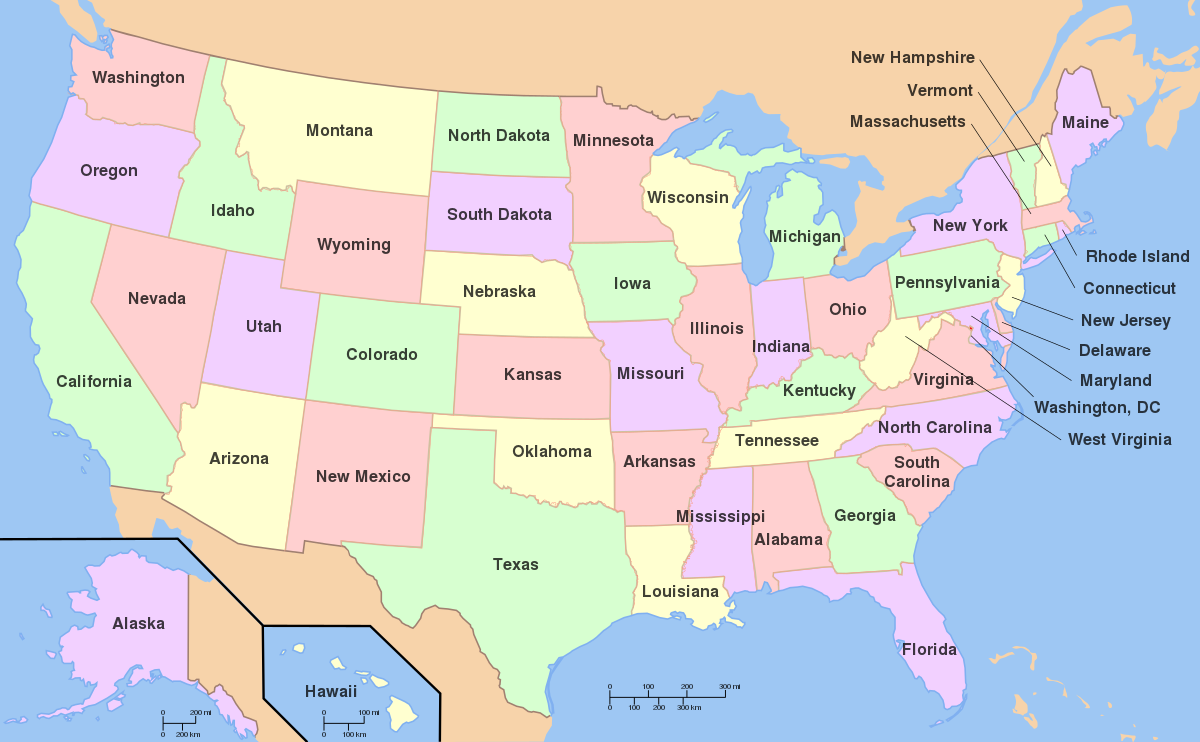A map of the United States with all 50 states and the District of Columbia. 48 states and the District of Columbia are contiguous, located north of Mexico and south of Canada. Alaska is located in the extreme northwest of North America, bordering Yukon and British Columbia, and Hawaii is located in the Pacific Ocean
The United States of America is a federal republic consisting of 50 states and one federal district (Washington, D.C.). States are the primary subdivisions of the United States, and possess a number of powers and rights under the United States Constitution, such as regulating intrastate commerce, running elections, creating local governments, and ratifying Constitutional amendments. Under the tenth amendment to the Constitution, the states can exercise all powers that are not delegated to the federal government. Each state has its own government, consisting of an executive branch, a legislative branch, and a judicial branch. They are all represented in the federal Congress – a bicameral legislature consisting of the Senate and the House of Representatives. Each state is represented by two Senators, while Representatives are awarded to each state in proportion to their total population. The federal district does not have representatives in the Senate, but has a non-voting delegate in the House. Each state is entitled to electors in the Electoral College, the body that elects the President of the United States, equal to the combined number of senators and representatives that state has in Congress. Congress can admit more states into the United States, but it cannot create a new state from territory of an existing state or merge two or more states into one without the consent of all states involved.
In addition to the 50 states and federal district, the United States has control over fourteen territories. Five of them (American Samoa, Guam, the Northern Mariana Islands, Puerto Rico, and the U.S. Virgin Islands) have a permanent, nonmilitary population, while nine of them (the United States Minor Outlying Islands) do not. With the exception of Navassa Island, Puerto Rico, and the U.S. Virgin Islands, which are located in the Caribbean, all territories are located in the Pacific Ocean. One territory, Palmyra Atoll, is considered to be incorporated, meaning the full body of the Constitution has been applied to it; the other territories are unincorporated, meaning the Constitution does not fully apply to them. Ten territories (the Minor Outlying Islands and American Samoa) are considered to be unorganized, meaning they have not had an Organic Act enacted by Congress; the four other territories are organized, meaning they have had an Organic Act that has been enacted by Congress. The five inhabited territories each have limited autonomy in addition to having territorial legislatures and governors, but residents cannot vote in federal elections.
Out of the 50 states, California is the most populous, with an estimated 38,041,430 residents as of 2012; Wyoming is the least populous, with an estimated 576,412 residents. The District of Columbia, with an estimated 632,323 residents as of 2012, has a higher population than the two least populous states (Wyoming and Vermont). The largest state by area is Alaska, encompassing 665,384 square miles (1,723,337 square kilometers), while the smallest is Rhode Island, encompassing 1,545 square miles (4,002 square kilometers). The first state to ratify the current Constitution was Delaware, which it did on December 7, 1787, while the newest state is Hawaii, which was admitted to the Union on August 21, 1959. The largest territory in terms of both population and size is Puerto Rico, which has 3,725,789 residents as of the 2010 census and a total area of 5,325 square miles (13,792 square kilometers).

No comments:
Post a Comment